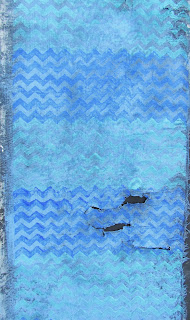 |
| (draft 4) |
"The Lord will give unyielding and impenetrable strength to His people; The Lord will bless His people with peace." (Psalm 29:11..Amplified) As you can see, I am still working on lettering. I thought about waiting until I was completely done, but decided it might be instructive to see the white charcoal pencil layout before it was all inked in.
Because of the value of the background, I chose white bleedproof gouache for the lettering. It echoes the value of the silver leaf and provides a readable, ethereal look to the text.
In order to write with a charcoal pencil on this type of surface, it is necessary to sharpen frequently...sharpen even more on a sandpaper block...and hold the pencil completely vertical. The nice thing about charcoal is the fact that it is easy to erase after all is finished.
The process has slowed down tremendously with the lettering so it will probably take me another day or two. It always pay off in the end because the scripture that speaks to the scribe will more than likely speak to many others.
I am actually writing the First Century Versals with a pointed pen (in case my lettering friends want to know) and then I plan to write the verse in Spanish and Spencerian Script. And there you have it, just a few more things to think about.



.jpg)
.jpg)






